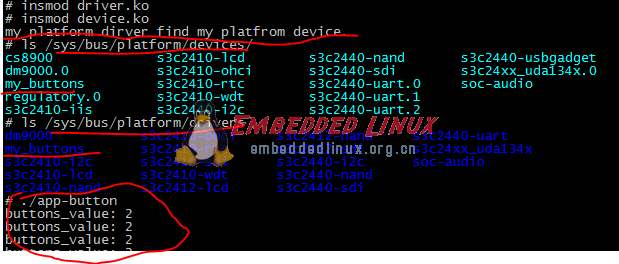驱动之路-platform简例按键驱动☆☆☆
一 、重要知识点:
▉1.platform设备模型
从Linux 2.6起引入了一套新的驱动管理和注册机制,platform_device和platform_driver,Linux中大部分的设备驱动都可以使用这套机制。platform是一条虚拟的总线。设备用platform_device表示,驱动用platform_driver进行注册,Linux platform driver机制和传统的device driver机制(通过driver_register进行注册)相比,一个明显的优势在于platform机制将设备本身的资源注册进内核,由内核统一管理,在驱动中使用这些资源时通过platform device提供的标准结构进行申请并使用。这样提高了驱动和资源的独立性,并且具有较好的可移植性和安全性(这些标准接口是安全的)。
pltform机制本身使用并不复杂,由两部分组成:platform_device和platform_driver。通过platform机制开发底层驱动的大致流程为:定义platform_deive->注册platform_device->定义platform_driver->注册platform_driver。
首先要确认的就是设备的资源信息,例如设备的地址,中断号等。
1 ● platform_device
在 2.6 内核中 platform 设备用结构体 platform_device 来描述,该结构体定义在 kernel/include/linux/platform_device.h 中,
structplatform_device {
const char * name;
u32 id;
struct device dev;
u32 num_resources;
struct resource * resource;
};
该结构一个重要的元素是resource ,该元素存入了最为重要的设备资源信息,定义在kernel/include/linux/ioport.h 中,
structresource {
const char *name;//资源的名称
unsigned long start, end;//资源起始的和结束的物理地址
unsigned long flags;//资源的类型,比如MEM,IO,IRQ类型
struct resource *parent, *sibling, *child;//资源链表的指针
};
structplatform_device的分配使用
structplatform_device *platform_device_alloc(const char *name, int id)
name是设备名,id,设备id,一般为-1,如果是-1,表示同样名字的设备只有一个
举个简单的例子,name/id是“serial/1”则它的bus_id就是serial.1 如果name/id是“serial/0”则它的bus_id就是serial.0 ,如果它的name/id是“serial/-1”则它的bus_id就是serial。
注册平台设备,使用函数
intplatform_device_add(struct platform_device *pdev)
注销使用
voidplatform_device_unregister(struct platform_device *pdev)
2 ● platform_driver
在平台设备驱动中获取平台设备资源使用
structresource *platform_get_resource(struct platform_device *dev, unsigned int type,unsigned int num)
该函数用于获取dev设备的第num个类型为type的资源,如果获取失败,则返回NULL。例如 platform_get_resource(pdev,IORESOURCE_IRQ, 0)。
平台驱动描述使用
structplatform_driver {
int (*probe)(struct platform_device *);
int (*remove)(struct platform_device *);
void (*shutdown)(struct platform_device *);
int (*suspend)(struct platform_device *, pm_message_t state);
int (*suspend_late)(struct platform_device *, pm_message_t state);
int (*resume_early)(struct platform_device *);
int (*resume)(struct platform_device *);
struct device_driver driver;
};
Probe()函数必须验证指定设备的硬件是否真的存在,probe()可以使用设备的资源,包括时钟,platform_data(platform_data:用户自定义的私有数据)等,Platform driver可以通过下面的函数完成对驱动的注册:
int platform_driver_register(structplatform_driver *drv);一般来说设备是不能被热插拔的,所以可以将probe()函数放在init段里面来节省driver运行时候的内存开销:
int platform_driver_probe(struct platform_driver *drv, int (*probe)(structplatform_device *));
注销使用void platform_driver_unregister(struct platform_driver *drv)
▉2.中断处理
在Linux驱动程序中,为设备实现一个中断包含 两个步骤1.向内核注册(申请中断)中断 2.实现中断处理函数
request_irq用于实现中断的注册
intrequest_irq(unsigned in irq, void(*handler)(int, void *, struct pt_regs *), unsigned long flags, const char *devname, void*dev_id)
向内核申请中断号为irq,中断处理函数为handler指针指向的函数,中断标志为flag,设备名为devname的中断。成功返回0,或者返回一个错误码。
当request_irq不用于共享中断时,dev_id可以为NULL,或者指向驱动程序自己的私有数据。但用于共享中断时dev_id必须唯一。因为free_irq时也需要dev_id做参数,这样free_irq才知道要卸载共享中断上哪个中断服务处理函数。共享中断会在后面讲到。
在flag参数中,可以选以下参数
IRQF_DISABLED(SA_INTERRUPT)
如果设置该位,表示是一个“快速”中断处理程序,如果没有,那么就是一个“慢速”中断处理程序。
IRQF_SHARED(SA_SHITQ)
该位表示中断可以在设备间共享。
快速/慢速中断
这两种类型的中断处理程序的主要区别在于:快速中断保证中断处理的原子性(不被打断),而慢速中断则不保证。换句话说,也就是开启中断标志位在运行快速中断处理程序时
关闭的,因此在服务该中断时,不会被其他类型的中断打断;而调用慢速中断处理时,其他类型中断扔可以得到服务。
共享中断
共享中断就是将不同的设备挂到同一个中断信号线上。linux对共享的支持主要是位PCI设备服务。
释放中断
voidfree_irq(unsigned int irq)
当设备不再需要使用中断时(通常是设备关闭和驱动卸载时),应该使用该函数把他们返回给内核使用。
禁用中断
voiddisable_irq(int irq)
当一些代码中不能使用中断时(如支持自旋锁的上下文中)使用该函数禁用中断。
启用中断
voidenable_irq(int irq)
当禁止后可以使用该函数重新启用。
◐二、驱动代码
该驱动实现能够读取按键按下的键值,比如说如果是第一个键按下读取的键值就为1。
platform平台设备
#include#include string.h> #include #include #include #include #include #include #include #include #include #include #include #include #include #include #include #include #include static struct resource key_resource[]= //⑦ { [0] = { .start = IRQ_EINT8, .end = IRQ_EINT8, .flags = IORESOURCE_IRQ, }, [1] = { .start = IRQ_EINT11, .end = IRQ_EINT11, .flags = IORESOURCE_IRQ, }, [2]= { .start = IRQ_EINT13, .end = IRQ_EINT13, .flags = IORESOURCE_IRQ, }, [3] = { .start = IRQ_EINT14, .end = IRQ_EINT14, .flags = IORESOURCE_IRQ, }, [4] = { .start = IRQ_EINT15, .end = IRQ_EINT15, .flags = IORESOURCE_IRQ, }, [5] = { .start = IRQ_EINT19, .end = IRQ_EINT19, .flags = IORESOURCE_IRQ, }, }; struct platform_device *my_buttons_dev; static int __init platform_dev_init(void) { int ret; my_buttons_dev = platform_device_alloc("my_buttons", -1); platform_device_add_resources(my_buttons_dev,key_resource,6);//添加资源一定要用该函数,不能使用对platform_device->resource幅值 //否则会导致platform_device_unregister调用失败,内核异常。 ret = platform_device_add(my_buttons_dev); if(ret) platform_device_put(my_buttons_dev); return ret; } static void __exit platform_dev_exit(void) { platform_device_unregister(my_buttons_dev); } module_init(platform_dev_init); module_exit(platform_dev_exit); MODULE_AUTHOR("Y-Kee"); MODULE_LICENSE("GPL");
platform平台驱动
//platform driver #include#include #include #include #include #include #include #include #include #include #include #include #include #include #include #include static int buttons_irq[6]; struct irq_des { int *buttons_irq; char *name[6]; }; struct irq_des button_irqs = { .buttons_irq = buttons_irq, .name = {"KEY0", "KEY1", "KEY2", "KEY3", "KEY4", "KEY5"}, }; static volatile int key_values; static DECLARE_WAIT_QUEUE_HEAD(button_waitq); static volatile int ev_press = 0; static irqreturn_t buttons_interrupt(int irq, void *dev_id) { int i; for(i=0; i<6; i++){ if(irq == buttons_irq[i]){ //④ key_values = i; ev_press = 1; wake_up_interruptible(&button_waitq); } } return IRQ_RETVAL(IRQ_HANDLED); } static int s3c24xx_buttons_open(struct inode *inode, struct file *file) { int i; int err = 0; for (i = 0; i < 6; i++) { err = request_irq(button_irqs.buttons_irq[i], buttons_interrupt, IRQ_TYPE_EDGE_BOTH, button_irqs.name[i], (void *)&button_irqs.buttons_irq[i]); if (err) break; } if (err) { i--; for (; i >= 0; i--) { if (button_irqs.buttons_irq[i] < 0) { continue; } disable_irq(button_irqs.buttons_irq[i]); free_irq(button_irqs.buttons_irq[i], (void *)&button_irqs.buttons_irq[i]); } return -EBUSY; } return 0; } static int s3c24xx_buttons_close(struct inode *inode, struct file *file) { int i; for (i = 0; i < 6; i++) { free_irq(button_irqs.buttons_irq[i], (void *)&button_irqs.buttons_irq[i]); } return 0; } static int s3c24xx_buttons_read(struct file *filp, char __user *buff, size_t count, loff_t *offp) { unsigned long err; if (!ev_press) { if (filp->f_flags & O_NONBLOCK) return -EAGAIN; else wait_event_interruptible(button_waitq, ev_press); } ev_press = 0; err = copy_to_user(buff, (const void *)&key_values, min(sizeof(key_values), count)); //③ return err ? -EFAULT : min(sizeof(key_values), count); } static unsigned int s3c24xx_buttons_poll( struct file *file, struct poll_table_struct *wait) { unsigned int mask = 0; poll_wait(file, &button_waitq, wait); if (ev_press) mask |= POLLIN | POLLRDNORM; return mask; } static struct file_operations dev_fops = { .owner = THIS_MODULE, .open = s3c24xx_buttons_open, .release = s3c24xx_buttons_close, .read = s3c24xx_buttons_read, .poll = s3c24xx_buttons_poll, }; static struct miscdevice misc = { .minor = MISC_DYNAMIC_MINOR, .name = "my_buttons", .fops = &dev_fops, }; static int my_plat_probe(struct platform_device *dev) { int ret,i; struct resource *plat_resource; struct platform_device *pdev = dev; printk("my platform dirver find my platfrom device.\n"); for(i=0; i<6; i++){ plat_resource = platform_get_resource(pdev,IORESOURCE_IRQ,i); //⑥ 获取platform总线中对应资源 file_operations从platform获取资源的核心语句 ☆☆☆ if(plat_resource == NULL) return -ENOENT; buttons_irq[i] = plat_resource->start; //⑤ } ret = misc_register(&misc); if(ret) return ret; return 0; } static int my_plat_remove(struct platform_device *dev) { printk("my platfrom device has removed.\n"); misc_deregister(&misc); return 0; } struct platform_driver my_buttons_drv = { .probe = my_plat_probe, .remove = my_plat_remove, .driver = { .owner = THIS_MODULE, .name = "my_buttons", }, }; static int __init platform_drv_init(void) { int ret; ret = platform_driver_register(&my_buttons_drv); return ret; } static void __exit platform_drv_exit(void) { platform_driver_unregister(&my_buttons_drv); } module_init(platform_drv_init); module_exit(platform_drv_exit); MODULE_AUTHOR("Y-Kee"); MODULE_LICENSE("GPL");
测试代码
/* * Buttons Example for Matrix V * * Copyright (C) 2004 capbily - friendly-arm * [email protected] */ #include#include #include #include #include #include #include #include select.h> #include #include int main(void) { int buttons_fd; int key_value; buttons_fd = open("/dev/buttons", 0); if (buttons_fd < 0) { perror("open device buttons"); exit(1); } for (;;) { fd_set rds; int ret; FD_ZERO(&rds); FD_SET(buttons_fd, &rds); ret = select(buttons_fd + 1, &rds, NULL, NULL, NULL); if (ret < 0) { perror("select"); exit(1); } if (ret == 0) { printf("Timeout.\n"); } else if (FD_ISSET(buttons_fd, &rds)) { int ret = read(buttons_fd, &key_value, sizeof key_value); //② if (ret != sizeof key_value) { if (errno != EAGAIN) perror("read buttons\n"); continue; } else { printf("buttons_value: %d\n", key_value+1); //① } } } close(buttons_fd); return 0; }
测试结果:
转载地址:http://www.cnblogs.com/Ph-one/p/4831393.html
